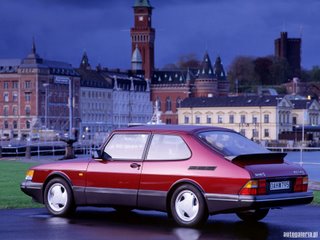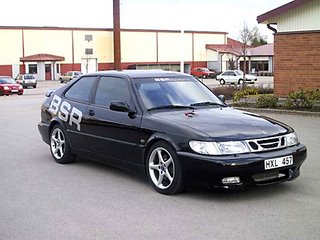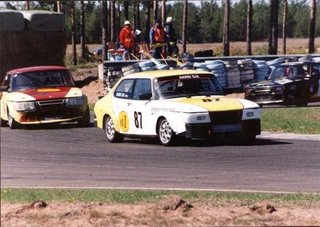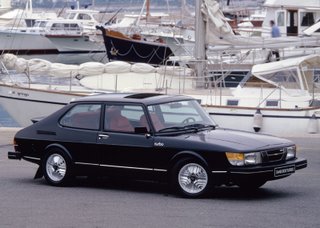




The 900, an automobile from Saab, was released in 1978 for the 1979 model year, and was produced through 1993 (some cabriolets were sold as 1994 models). It was based on the Saab 99 chassis, but had a longer front end to meet U.S. frontal crash regulations. The drag coefficient was 0.34. The 900 was produced in 2- and 4-door sedan, and 3- and 5-door coupe configurations; additionally, from 1986, a cabriolet (convertible) model was produced. There were single- and twin carburetor, fuel-injection and turbocharged engines, including both full pressure (FPT) and in European models during the early 90s, low pressure turbos (LPT).
The Saab 900 was a front-engined, front-wheel-drive compact car with a longitudinally-mounted, 45-degree slanted, inline 4-cylinder engine, double wishbone front suspension and beam-axle rear suspension. In its heyday, the 900 was popular with drivers who enjoyed its comfort, safety, practicality (especially hatchbacks), and highway driving manners.
Like its predecessor the 99, the 900 contained a number of unusual design features that distinguish it from most other cars. Firstly, the engine was installed 'backwards', with power delivered from the crank at the front of the car. Secondly, the transmission, technically a transaxle, bolted directly to the bottom of the engine (albeit with separate oil lubrication). Power from the crank would thus be delivered out of the engine at the front, then transferred down and back to the transmission below, via a set of chain-driven primary gears. Similarly, Minis also had their gearbox mounted directly below the engine; however, the Mini gearbox and engine shared the same oil, whereas the Saab 900 (and 99) gearboxes contained a separate sump for engine oil.
Very few front-wheel drive cars utilized a longitudinally-mounted engine configuration. Fewer still utilized a double wishbone suspension design. Refined over several decades of two-digit Saab models, the 900's double wishbone design provided excellent handling and road feel. The rear suspension comprised a typical beam axle design, stabilized with a Panhard rod. However, the attachment points between the axle and chassis made up an unusual configuration that essentially consists of two Watt's linkages at either end of the axle: a lower control arm attaches the axle to the bottom of the vehicle, while an upper link attaches at the top but faces towards the rear, unlike a typical 4-link design with both lower and upper links facing forward.
Early models did not have sway bars; they began appearing on certain models in 1985 and in U.S. and possibly other markets, became standard on all trim levels by the late 1980s. The sway bars decreased body roll, but at the expense of some ride comfort and when driven aggressively, increased inside wheelspin. The front and rear bars' diameters were unchanged throughout the model's run.
Stylistically, the 900 utilized a deeply curved front windshield, calling attention to the marque's aircraft legacy. The hatchback, or Combi Coupé cars were exceptionally spacious, if not universally loved for their aesthetics. Also underscoring their aircraft lineage, the 900's dashboard was curved to enable easy reach of all controls and featured back-lit gauges. Saab engineers placed all controls and gauges in the dashboard according to their frequency of use and/or importance so that the driver need divert his gaze from the road for the shortest possible time and by the smallest angle. This is why, for example, the oft-used radio is placed so high in the dashboard.
The 900 underwent minor cosmetic design changes for 1987, including restyled front-end and bumpers; sheetmetal body parts were unchanged. Being a small car factory, for economic reasons, Saab kept the basic undercarriage more or less unchanged throughout the 900's production run.
The Saab 900 could be ordered with different options. One highly sought-after option was called the Aero or Special Performance Group (SPG), as it was known in the U.S. The Aero/SPG incorporated (depending on the market and model year) a body skirt; a sport-suspension (1987+) that included shorter, stiffer springs, stiffer shocks, and swaybars; leather seats; premium stereo, and air conditioning. Each of these features could, of course, be ordered independently from Saab's Accessories Catalog for fitment to standard models. Power output varied by model year and market but models produced after 1985 were fitted with a 16-valve turbocharged engine.
The Saab 900 was a front-engined, front-wheel-drive compact car with a longitudinally-mounted, 45-degree slanted, inline 4-cylinder engine, double wishbone front suspension and beam-axle rear suspension. In its heyday, the 900 was popular with drivers who enjoyed its comfort, safety, practicality (especially hatchbacks), and highway driving manners.
Like its predecessor the 99, the 900 contained a number of unusual design features that distinguish it from most other cars. Firstly, the engine was installed 'backwards', with power delivered from the crank at the front of the car. Secondly, the transmission, technically a transaxle, bolted directly to the bottom of the engine (albeit with separate oil lubrication). Power from the crank would thus be delivered out of the engine at the front, then transferred down and back to the transmission below, via a set of chain-driven primary gears. Similarly, Minis also had their gearbox mounted directly below the engine; however, the Mini gearbox and engine shared the same oil, whereas the Saab 900 (and 99) gearboxes contained a separate sump for engine oil.
Very few front-wheel drive cars utilized a longitudinally-mounted engine configuration. Fewer still utilized a double wishbone suspension design. Refined over several decades of two-digit Saab models, the 900's double wishbone design provided excellent handling and road feel. The rear suspension comprised a typical beam axle design, stabilized with a Panhard rod. However, the attachment points between the axle and chassis made up an unusual configuration that essentially consists of two Watt's linkages at either end of the axle: a lower control arm attaches the axle to the bottom of the vehicle, while an upper link attaches at the top but faces towards the rear, unlike a typical 4-link design with both lower and upper links facing forward.
Early models did not have sway bars; they began appearing on certain models in 1985 and in U.S. and possibly other markets, became standard on all trim levels by the late 1980s. The sway bars decreased body roll, but at the expense of some ride comfort and when driven aggressively, increased inside wheelspin. The front and rear bars' diameters were unchanged throughout the model's run.
Stylistically, the 900 utilized a deeply curved front windshield, calling attention to the marque's aircraft legacy. The hatchback, or Combi Coupé cars were exceptionally spacious, if not universally loved for their aesthetics. Also underscoring their aircraft lineage, the 900's dashboard was curved to enable easy reach of all controls and featured back-lit gauges. Saab engineers placed all controls and gauges in the dashboard according to their frequency of use and/or importance so that the driver need divert his gaze from the road for the shortest possible time and by the smallest angle. This is why, for example, the oft-used radio is placed so high in the dashboard.
The 900 underwent minor cosmetic design changes for 1987, including restyled front-end and bumpers; sheetmetal body parts were unchanged. Being a small car factory, for economic reasons, Saab kept the basic undercarriage more or less unchanged throughout the 900's production run.
The Saab 900 could be ordered with different options. One highly sought-after option was called the Aero or Special Performance Group (SPG), as it was known in the U.S. The Aero/SPG incorporated (depending on the market and model year) a body skirt; a sport-suspension (1987+) that included shorter, stiffer springs, stiffer shocks, and swaybars; leather seats; premium stereo, and air conditioning. Each of these features could, of course, be ordered independently from Saab's Accessories Catalog for fitment to standard models. Power output varied by model year and market but models produced after 1985 were fitted with a 16-valve turbocharged engine.
No comments:
Post a Comment